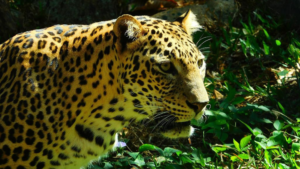
Indian Leopard
A stealthy predatorin Pakistan’s mountainous and forested regions
Conservation Status | Endangered
The Indian Leopard, locally known as Chita, is a powerful and agile big cat found in various habitats across South Asia, including parts of Pakistan. Known for its striking spotted coat, this elusive predator is both admired and feared. It plays a vital role in controlling herbivore populations, ensuring the health of ecosystems.
Habitat & Lifestyle
In Pakistan, Indian Leopards inhabit rugged mountainous terrains, forests, and scrublands, primarily in regions like Azad Jammu and Kashmir, Khyber Pakhtunkhwa, and Balochistan. They are solitary and nocturnal, with exceptional climbing skills, often seen resting in trees during the day. Their diet includes deer, wild boar, monkeys, and smaller mammals. Indian Leopards are also opportunistic feeders, occasionally preying on livestock, leading to human-wildlife conflicts.
Area Found
Indian Leopards are found in the Margalla Hills near Islamabad, parts of Azad Jammu and Kashmir, and other forested or hilly areas in northern and western Pakistan. Their presence in these regions is indicative of relatively undisturbed habitats.
Quick Facts
- Size: 4ft 2in to 4ft 8in in body size with a 2ft 6in to 3ft long tail
- Weight: 50-90 kg
- Appearance: Golden-yellow coat with rosette-shaped black spots and a long tail for balance
- Primary predators: Adult leopards face few natural predators; cubs may fall prey to other big cats or large carnivores
- Unique Feature: Their adaptability allows them to thrive in a variety of habitats, from dense forests to arid landscapes




Did you spot a mistake or have more to add? Let us know!
Your feedback helps Haewan keep information accurate and up-to-date.
